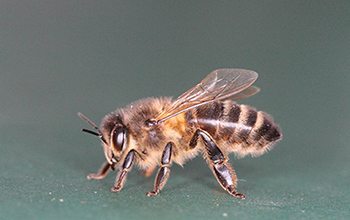
The dark European honey bee Apis mellifera mellifera (Figure 1) was originally distributed throughout much of northern Europe, from France and the British Isles in the west to western Russia in the east. It was also almost certainly the first honey bee introduced to north America. However, over several hundred years, but especially in the late 20th century, the native bee was in many places throughout Europe replaced by other strains of honey bee, most notably the Italian bee A. m. ligustica, the Carniolan bee A. m. carnica and the hybrid “Buckfast” bee, all of which were considered to be “better” than the native bee in a number of ways, most notably in honey production.
Indeed, in many parts of Europe A. m. mellifera was thought to be extinct. This view was reinforced in particular by Brother Adam in England, who in 1983 wrote that “The old English brown bee… lives today only in the memory. Some 50 years ago she fell a victim to the acarine epidemic and was completely wiped out.” By “acarine” he meant the tracheal mite Acarapis woodi, at that time thought to have been the cause of the “Isle of Wight Disease,” which was blamed for all colony losses in the British Isles in the early 20th century. Not only that, he and others aided the unpopularity of the dark bee with stories of their bad temper, which hindsight suggests may have actually been the result of hybridization with other strains.
Work by a small number of groups of mainly hobby beekeepers in several countries who valued these native bees established that populations of it did still exist. They discovered its existence mainly using the technique of wing morphometry. Although still alive, it was often hybridized (introgressed) with other strains of bee.
SICAMM (Societas Internationalis pro Conservatione Apis melliferae melliferae) was founded in 1995 at Flekkefjord, Norway by beekeepers and scientists from Austria, Denmark, Germany, Norway, Poland, Sweden, Switzerland and the UK as an international association devoted to the protection of the dark European honey bee. One of its main purposes has been to organize regular international conferences, and I was recently pleased to attend the 2018 Conference held in Finland, hosted by the Finnish Beekeepers Association (Suomen Mehiläishoitajain Liitto).
The conference was attended by 66 delegates from 13 different countries and was held at the Mustiala Agricultural Institute, near Helsinki. The Mustiala Agricultural Institute was the first agricultural school in Finland, established in 1840 (Figures 2 & 3), and has long featured beekeeping as one of its enterprises. Mustalia is now part of the larger HAMK (Häme University of Applied Sciences) which runs a range of land based training courses (including beekeeping) at a variety of levels from several campuses. Like much of northern Europe, Finland was experiencing unusually warm weather at the time of the conference, which was commented on by those from more southerly climes.
The main part of the conference consisted of some 33 talks on a variety of topics related to the dark bee. Keynote speakers were Bjørn Dahle from Norway talking about the EU funded SMARTBEES project on bee breeding, which is due to be completed later this year, and Ralph Büchler from Germany on how honey bee mating behavior drives selection for local adaptation and disease resistance. Other talks covered the conservation of dark bees in Belgium, Estonia, Finland, Germany, Ireland, the Netherlands, Norway, Poland, Sweden, Switzerland and the UK.
A number of common themes emerged from these talks. Firstly there is much evidence of a growing interest and enthusiasm for dark bees among beekeepers in most countries in which they are native, with a number of new breeding groups established in the last few years such as the Scottish Native Honey Bee Society and the B4 (Bringing Back Black Bees) Project in the UK, along with others elsewhere.
Secondly, a number of recent molecular studies have conclusively demonstrated that significant populations of dark bees do indeed still exist in many countries. Notable at the conference were the talks by Jack Hassett and Keith Browne who have demonstrated that Ireland probably holds the largest pure populations of the dark European honey bee anywhere. In their studies, 97.8% of bee samples from ….


